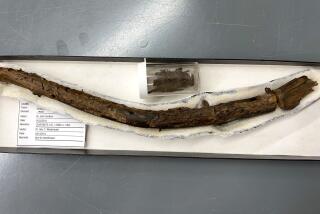U. S. Lists 2 Regional Plants as Endangered Species
Two rare plants that eke out an existence in the scrub-ringed grasslands of the Conejo Valley and limestone outcroppings of the Simi Hills and Oak Park were listed Wednesday as endangered species, officials said.
A delicate yellow flower commonly called Lyonâs pentachaeta and a striking mauve-blossomed herb called Brauntonâs milk-vetch will receive protection under the federal Endangered Species Act, said Tim Thomas, a Ventura-based botanist with the U. S. Fish & Wildlife Service, which announced the listings.
Lyonâs pentachaeta--which makes its home in the clay-laden soil and some grasslands of Thousand Oaks and Moorpark--was cited as a reason to scale back a massive 458-acre Seventh-day Adventist development north of the Ventura Freeway in Newbury Park more than a year ago.
âThereâs a plant thatâs just literally slipping off the face of the Earth,â Thomas said. âThereâs a moral value and thereâs an aesthetic appeal to these plants--theyâre neat little things--and thereâs a need to maintain their future opportunities. Thereâs also a scientific value that these plants have.â
Native plant enthusiasts in the county hailed the new listings as a moral victory, but said the practical value of the listings is limited.
âMost of the plant populations are located on private land, so federal listing really doesnât come into play,â said Carl Wishner, a consultant for Agoura Hills-based Envicom Corp., which advises public and private organizations on biological concerns.
Thatâs because the Endangered Species Act offers much weaker protection for plants than it does for animals. And even the force of federal law may not save many plants on private land, unless a proposed development receives federal funding or has some other connection to the federal government.
However, on public land, it will offer new means of protecting plants and their habitat, Thomas said.
In practical terms, that means the listings will likely affect the routes of hiking trails in the Santa Monica Mountains National Recreation Area, but private property, such as the Seventh-day Adventist project--planned for an area of Thousand Oaks dotted with dainty Lyonâs pentachaeta blossoms--will likely remain unchanged.
With luck, listing Lyonâs pentachaeta as endangered could prompt voluntary changes in the Seventh-day Adventist project--which includes relocating a high school, elementary and preschool plus adding housing on 458 acres, said Thousand Oaks Councilwoman Linda Parks who, when she was a planning commissioner, fought to limit the development.
âBut I donât have much hope,â she said. âI think you just [should not] mess with these plants.â
As soon as a plant is considered for endangered status--which typically happens years before the actual listing--the National Park Service takes action.
âThe first thing weâre really interested in is knowing where they are and how theyâre doing, so we can protect them,â said park service ecologist Ray Sauvajot, stationed in the Santa Monica Mountains recreation area. âThat may mean rerouting trails or putting up fencing in sensitive areas.â
Both flowers seem to thrive after fires. Brauntonâs milk-vetch is commonly called a âfire followerâ because it typically flourishes two or three years after a wildfire, then fades away, leaving seeds to be triggered by the next fire, which may not occur for another 20 to 100 years.
Experts say the listings do heighten public awareness of how many of Southern Californiaâs native plants are threatened by development, over-collecting and the invasion of nonnative weeds.
In addition to the two plants listed as endangered, four others indigenous to Ventura County were listed as threatened. They are rock plants, known as âdudleyasâ--or live-forevers: the marcescent dudleya, Santa Monica Mountains dudleya, Conejo dudleya and Verityâs dudleya.
More to Read
Sign up for Essential California
The most important California stories and recommendations in your inbox every morning.
You may occasionally receive promotional content from the Los Angeles Times.










